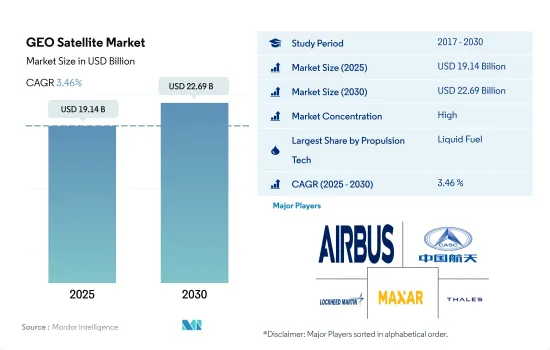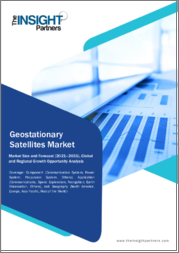
|
시장보고서
상품코드
1693941
GEO 위성 시장(2025-2030년) : 시장 점유율 분석, 산업 동향 및 통계, 성장 예측GEO Satellite - Market Share Analysis, Industry Trends & Statistics, Growth Forecasts (2025 - 2030) |
||||||
■ 보고서에 따라 최신 정보로 업데이트하여 보내드립니다. 배송일정은 문의해 주시기 바랍니다.
GEO 위성 시장 규모는 2025년에 191억 4,000만 달러로 예측되고, 2030년에는 226억 9,000만 달러에 이를 전망이며 예측 기간(2025-2030년) 동안 CAGR 3.46%를 보일 것으로 예측됩니다.

액체연료 추진은 예측 기간 동안 급증할 전망
- 위성 추진 시스템은 속도와 방향을 바꾸는 데 중요한 역할을 하며 또한 궤도에서 우주선의 위치를 조정하는 데 사용됩니다. 궤도상의 우주선은 지구와 태양에 대한 자세를 수정하기 위해 자세 제어가 필요합니다. 경우에 따라 위성을 궤도에서 이동시켜야 하며 궤도에 적응할 수 있는 능력이 없으면 위성은 죽은 것으로 간주됩니다. 따라서 파워트레인 시스템의 중요성은 시장 성장을 가속할 것으로 예측됩니다. 연료 유형은 목적에 따라 구분됩니다. 액체 추진제를 사용하는 로켓 엔진은 액체 추진제를 사용합니다. 가스 연료도 사용할 수 있지만 밀도가 낮고 기존의 압송 방법으로는 어려우므로 별로 보급되지 않습니다. 2020년에는 팬데믹에 의해 직면한 제조 및 운용상의 과제에 의해 시장은 44% 감소했습니다.
- 이를 가능하게 한 액체 시스템은 고효율이고 신뢰성이 높은 것으로 입증되었으며 강력한 추력이나 신속한 조종이 필요한 경우에 사용됩니다.
- 한편, 전기 추진은 상업 통신 위성의 스테이션 유지에 일반적으로 사용되고 있으며 높은 비추력에 의해 일부 우주 탐사 미션의 주요 추진력으로 사용되고 있습니다.
- 세계의 GEO 위성 시장은 다양한 산업에 걸친 다양한 위성 용도에 견인되어 향후 수년간 크게 성장할 것으로 예측됩니다. 2017-2022년 사이에, 147기의 위성이 제조되어 이 부문의 다양한 오퍼레이터에 의해 GEO에 발사되었습니다.
- 북미는 Boeing, Lockheed Martin, Northrop Grumman 등 여러 대형 시장 참가 기업의 존재로 세계의 GEO 위성 시장을 독점할 것으로 예상되고 있습니다.
- 유럽에서는 고속 인터넷과 통신 서비스 수요 증가에 따라 GEO 위성 시장의 대폭적인 성장이 예상되고 있습니다.
- 아시아태평양에서는 지역의 정부와 민간 조직에 의한 위성기술과 인프라 개발에 대한 투자가 증가하고 있으며, 이 시장의 성장을 더욱 끌어올릴 것으로 기대되고 있습니다.
세계의 GEO 위성 시장 동향
인공위성은 보다 선진적인 통신장치, 선진적인 화상처리기능, 선진적인 센서를 탑재하고 있으며 탑재 기능은 질량에 영향을 미칩니다.
- GEO(정지지구궤도) 위성의 질량은 특정 설계, 목적, 통합된 기술적 진보에 따라 변화할 수 있습니다. 질량은 진보와 위성 페이로드의 복잡화에 기인하여 증가하는 일반적인 추세에 있었습니다.
- 고처리량 위성(HTS)은 데이터 용량을 강화하고 통신 속도를 가속화하기 위해 설계되었습니다.
- GEO 위성은 주로 통신의 중계 역할을 하며 TV 방송, 인터넷 접속, 통신 등의 서비스를 제공하고 있습니다. 2017년부터 2022년 사이에 세계적으로 140기 이상의 위성이 GEO로 발사되었습니다.
세계 시장의 성장은 고유한 우주 능력에 의해 지원될 것으로 예상
- 정지 궤도는 지구의 적도 상공 약 35,786km의 고도에 위치하는 원 궤도입니다.
- 캐나다 정부에 따르면 캐나다 우주산업은 국가 GDP의 23억 달러를 차지하며 1만명의 고용을 창출하고 있습니다. 우주산업의 90%는 중소기업입니다.
- 아시아태평양에서는 현재 중국, 인도, 일본만이 위성, 로켓, 우주항의 제조를 포함한 모든 통신위성, 지구관측위성(EO), 항법위성을 위한 완전한 우주인프라와 기술을 가지고 있으며, 완전한 엔드 투 엔드 우주능력을 가지고 있습니다. 그러나 이 지역의 많은 나라들이 최신의 민첩한 전략의 일환으로 고유의 우주 능력을 개발하면서 이 동향은 향후 몇 년간 어느 정도 변화할 것으로 예측됩니다.
GEO 위성 산업 개요
GEO 위성 시장은 상당히 통합되어 있으며 상위 5개 기업에서 88.46%를 차지하고 있습니다.
기타 혜택
- 엑셀 형식 시장 예측(ME) 시트
- 3개월간 애널리스트 서포트
목차
제1장 주요 요약과 주요 조사 결과
제2장 보고서 제안
제3장 소개
- 조사의 전제조건과 시장 정의
- 조사 범위
- 조사 방법
제4장 주요 산업 동향
- 위성의 질량
- 우주 개발에의 지출
- 규제 프레임워크
- 세계
- 호주
- 브라질
- 캐나다
- 중국
- 프랑스
- 독일
- 인도
- 이란
- 일본
- 뉴질랜드
- 러시아
- 싱가포르
- 한국
- 아랍에미리트(UAE)
- 영국
- 미국
- 밸류체인과 유통채널 분석
제5장 시장 세분화
- 용도
- 통신
- 지구 관측
- 네비게이션
- 우주 관측
- 기타
- 위성 질량
- 10-100kg
- 100-500kg
- 500-1,000kg
- 1,000kg 이상
- 최종 사용자
- 상업
- 군사 및 정부
- 추진 기술
- 전기
- 가스
- 액체 연료
- 지역
- 아시아태평양
- 유럽
- 북미
- 기타
제6장 경쟁 구도
- 주요 전략 동향
- 시장 점유율 분석
- 기업 상황
- 기업 프로파일
- Airbus SE
- China Aerospace Science and Technology Corporation(CASC)
- Indian Space Research Organisation(ISRO)
- Japan Aerospace Exploration Agency(JAXA)
- Lockheed Martin Corporation
- Maxar Technologies Inc.
- Mitsubishi Heavy Industries
- Northrop Grumman Corporation
- Thales
- The Boeing Company
제7장 CEO에 대한 주요 전략적 질문
제8장 부록
- 세계 개요
- 개요
- Porter's Five Forces 분석 프레임워크
- 세계의 밸류체인 분석
- 시장 역학(DROs)
- 정보원과 참고문헌
- 도표 일람
- 주요 인사이트
- 데이터 팩
- 용어집
The GEO Satellite Market size is estimated at 19.14 billion USD in 2025, and is expected to reach 22.69 billion USD by 2030, growing at a CAGR of 3.46% during the forecast period (2025-2030).

Liquid fuel propulsion is expected to surge during the forecast period
- A satellite's propulsion system plays a key role in changing its speed and direction. It is also used to adjust the position of the spacecraft in orbit. After entering orbit, the spacecraft requires attitude control to correct its orientation with respect to the Earth and the Sun. In some cases, it is necessary to move the satellite out of orbit, and without the ability to adapt to orbit, the satellite is considered dead. Therefore, the importance of powertrain systems is expected to drive market growth. Different types of fuel are used for different purposes. Liquid propellants use rocket engines that use liquid propellants. Gas fuels can also be used but are less popular due to their low density and difficulty using conventional pumping methods. In 2020, the market was declined by 44%, impacted by the manufacturing and operational challenges faced by the pandemic.
- The liquid system that made it possible has proven to be highly efficient and reliable. These include hydrazine systems, single or dual propulsion systems, hybrid systems, cold/hot air systems, and solid propellants. It is used when strong thrust or quick maneuvering is required. Therefore, liquid systems will continue to be the space propulsion technology of choice if their total thrust capacity is sufficient to meet mission requirements.
- On the other hand, electric propulsion is commonly used to hold stations for commercial communications satellites, and its high specific impulse makes it the primary propulsion for some space exploration missions. The utilization of electric propulsion systems is expected to surge during 2023-2029, and the overall market is expected to surge by 22%. New satellite launches are expected to accelerate market growth during the forecast period.
- The global GEO satellite market is expected to grow significantly in the coming years, driven by various satellite applications across different industries. The market can be analyzed concerning North America, Europe, and Asia-Pacific, which are the major regions in terms of market share and revenue generation. Between 2017 and 2022, 147 satellites were manufactured and launched by various operators in this segment into GEO. Of these 147 satellites, nearly 75% were launched for communication purposes.
- North America is expected to dominate the global GEO satellite market due to the presence of several leading market players, such as Boeing, Lockheed Martin, and Northrop Grumman. The increasing demand for high-speed internet, navigation services, and remote sensing applications in the region is expected to fuel market growth. Between 2017 and 2022, the region accounted for 30% of the total satellites manufactured and launched into GEO.
- In Europe, the GEO satellite market is expected to grow significantly due to the increasing demand for high-speed internet and communication services. The ESA has been investing heavily in the development of advanced satellite technology, which is expected to further drive the growth of the market in the region. During 2017-2022, the region accounted for 11% of the total satellites manufactured and launched into GEO.
- In Asia-Pacific, increasing investments in the development of satellite technology and infrastructure by governments and private organizations in the region are expected to further boost the growth of the market. During 2017-2022, the region accounted for 59% of the total satellites manufactured and launched into GEO.
Global GEO Satellite Market Trends
Satellites are equipped with more sophisticated communication devices, advanced imaging capabilities, and advanced sensors that, in addition to other functions, contribute to their mass
- The mass of GEO (geostationary Earth orbit) satellites can vary depending on their specific design, purpose, and the technological advancements integrated. However, certain trends and general considerations have shaped the mass of GEO satellites over time. Over the years, there has been a general trend of increasing the mass of GEO satellites, mainly due to advances in technology and the increasing complexity of satellite payloads. Satellites now carry more advanced communications equipment, high-resolution imaging systems, and sophisticated sensors that, among other capabilities, contribute to their overall mass.
- High-throughput satellites (HTS) are designed to provide enhanced data capacity and faster communication speeds. These satellites employ advanced antenna systems, multiple spot beams, and frequency reuse techniques to maximize their communication capabilities. The additional complexity and larger communication payloads of HTS can result in higher satellite masses.
- GEO satellites primarily serve as relays for communications, providing services such as television broadcasting, internet connectivity, and telecommunications. The size and volume of the communication payload have increased as the demand for higher bandwidth and more advanced services has increased. To accommodate larger and more powerful communications equipment, GEO satellites have become heavier. During 2017-2022, over 140 satellites were launched in GEO globally. The surge in the number of military satellites is expected to aid the GEO satellite segment in the forecast period.
The growth of the global market is expected to be supported by indigenous space capabilities
- A geostationary orbit is a circular orbit located at an altitude of approximately 35,786 km above the Earth's equator. GEO satellites offer a range of market applications and services such as communications, navigation, surveillance, remote sensing, weather forecasting, satellite broadcasting, and internet services. Between 2017 and May 2022, over 145+ GEO satellites were launched globally.
- The Canadian space industry adds USD 2.3 billion to the country's GDP and employs 10,000 people, according to the government. The government reports that 90% of Canadian space firms are small- and medium-sized businesses. The Canadian Space Agency's (CSA) budget is modest, with its budgetary spending for 2022-23 estimated at USD 329 million.
- In Asia-Pacific, currently, only China, India, and Japan have full end-to-end space capacity and complete space infrastructure and technology for all communication, Earth observation (EO), and navigation satellites, including for the manufacturing of satellites, rockets, and spaceports. Other countries in the region rely on international cooperation to carry out their respective space programs. However, this trend is expected to change to some extent over the coming years, although many countries in the region are developing indigenous space capabilities as part of their latest agile strategies. In June 2022, South Korea launched the Nuri rocket, putting six satellites into orbit, making it the seventh country in the world to successfully launch a payload weighing more than one ton.
GEO Satellite Industry Overview
The GEO Satellite Market is fairly consolidated, with the top five companies occupying 88.46%. The major players in this market are Airbus SE, China Aerospace Science and Technology Corporation (CASC), Lockheed Martin Corporation, Maxar Technologies Inc. and Thales (sorted alphabetically).
Additional Benefits:
- The market estimate (ME) sheet in Excel format
- 3 months of analyst support
TABLE OF CONTENTS
1 EXECUTIVE SUMMARY & KEY FINDINGS
2 REPORT OFFERS
3 INTRODUCTION
- 3.1 Study Assumptions & Market Definition
- 3.2 Scope of the Study
- 3.3 Research Methodology
4 KEY INDUSTRY TRENDS
- 4.1 Satellite Mass
- 4.2 Spending On Space Programs
- 4.3 Regulatory Framework
- 4.3.1 Global
- 4.3.2 Australia
- 4.3.3 Brazil
- 4.3.4 Canada
- 4.3.5 China
- 4.3.6 France
- 4.3.7 Germany
- 4.3.8 India
- 4.3.9 Iran
- 4.3.10 Japan
- 4.3.11 New Zealand
- 4.3.12 Russia
- 4.3.13 Singapore
- 4.3.14 South Korea
- 4.3.15 United Arab Emirates
- 4.3.16 United Kingdom
- 4.3.17 United States
- 4.4 Value Chain & Distribution Channel Analysis
5 MARKET SEGMENTATION (includes market size in Value in USD, Forecasts up to 2030 and analysis of growth prospects)
- 5.1 Application
- 5.1.1 Communication
- 5.1.2 Earth Observation
- 5.1.3 Navigation
- 5.1.4 Space Observation
- 5.1.5 Others
- 5.2 Satellite Mass
- 5.2.1 10-100kg
- 5.2.2 100-500kg
- 5.2.3 500-1000kg
- 5.2.4 above 1000kg
- 5.3 End User
- 5.3.1 Commercial
- 5.3.2 Military & Government
- 5.4 Propulsion Tech
- 5.4.1 Electric
- 5.4.2 Gas based
- 5.4.3 Liquid Fuel
- 5.5 Region
- 5.5.1 Asia-Pacific
- 5.5.2 Europe
- 5.5.3 North America
- 5.5.4 Rest of World
6 COMPETITIVE LANDSCAPE
- 6.1 Key Strategic Moves
- 6.2 Market Share Analysis
- 6.3 Company Landscape
- 6.4 Company Profiles (includes Global Level Overview, Market Level Overview, Core Business Segments, Financials, Headcount, Key Information, Market Rank, Market Share, Products and Services, and Analysis of Recent Developments).
- 6.4.1 Airbus SE
- 6.4.2 China Aerospace Science and Technology Corporation (CASC)
- 6.4.3 Indian Space Research Organisation (ISRO)
- 6.4.4 Japan Aerospace Exploration Agency (JAXA)
- 6.4.5 Lockheed Martin Corporation
- 6.4.6 Maxar Technologies Inc.
- 6.4.7 Mitsubishi Heavy Industries
- 6.4.8 Northrop Grumman Corporation
- 6.4.9 Thales
- 6.4.10 The Boeing Company
7 KEY STRATEGIC QUESTIONS FOR SATELLITE CEOS
8 APPENDIX
- 8.1 Global Overview
- 8.1.1 Overview
- 8.1.2 Porter's Five Forces Framework
- 8.1.3 Global Value Chain Analysis
- 8.1.4 Market Dynamics (DROs)
- 8.2 Sources & References
- 8.3 List of Tables & Figures
- 8.4 Primary Insights
- 8.5 Data Pack
- 8.6 Glossary of Terms
샘플 요청 목록

















